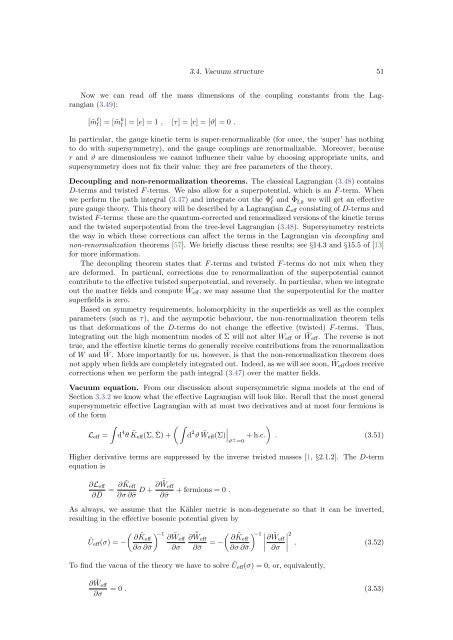The Bethe/Gauge Correspondence
The Bethe/Gauge Correspondence
The Bethe/Gauge Correspondence
You also want an ePaper? Increase the reach of your titles
YUMPU automatically turns print PDFs into web optimized ePapers that Google loves.
3.4. Vacuum structure 51Now we can read off the mass dimensions of the coupling constants from the Lagrangian(3.49):[ ˜m l f ] = [ ˜m k¯f ] = [e] = 1 , [τ] = [r] = [ϑ] = 0 .In particular, the gauge kinetic term is super-renormalizable (for once, the ‘super’ has nothingto do with supersymmetry), and the gauge couplings are renormalizable. Moreover, becauser and ϑ are dimensionless we cannot influence their value by choosing appropriate units, andsupersymmetry does not fix their value: they are free parameters of the theory.Decoupling and non-renormalization theorems. <strong>The</strong> classical Lagrangian (3.48) containsD-terms and twisted F -terms. We also allow for a superpotential, which is an F -term. Whenwe perform the path integral (3.47) and integrate out the Φ l fand ¯Φ¯f,k we will get an effectivepure gauge theory. This theory will be described by a Lagrangian L eff consisting of D-terms andtwisted F -terms: these are the quantum-corrected and renormalized versions of the kinetic termsand the twisted superpotential from the tree-level Lagrangian (3.48). Supersymmetry restrictsthe way in which these corrections can affect the terms in the Lagrangian via decoupling andnon-renormalization theorems [57]. We briefly discuss these results; see §14.3 and §15.5 of [13]for more information.<strong>The</strong> decoupling theorem states that F -terms and twisted F -terms do not mix when theyare deformed. In particual, corrections due to renormalization of the superpotential cannotcontribute to the effective twisted superpotential, and reversely. In particular, when we integrateout the matter fields and compute ˜W eff , we may assume that the superpotential for the mattersuperfields is zero.Based on symmetry requirements, holomorphicity in the superfields as well as the complexparameters (such as τ), and the asympotic behaviour, the non-renormalization theorem tellsus that deformations of the D-terms do not change the effective (twisted) F -terms. Thus,integrating out the high momentum modes of Σ will not alter W eff or ˜W eff . <strong>The</strong> reverse is nottrue, and the effective kinetic terms do generally receive contributions from the renormalizationof W and ˜W . More importantly for us, however, is that the non-renormalization theorem doesnot apply when fields are completely integrated out. Indeed, as we will see soon, ˜W eff does receivecorrections when we perform the path integral (3.47) over the matter fields.Vacuum equation. From our discussion about supersymmetric sigma models at the end ofSection 3.3.2 we know what the effective Lagrangian will look like. Recall that the most generalsupersymmetric effective Lagrangian with at most two derivatives and at most four fermions isof the form∫( ∫L eff = d 4 θ ˜K eff (Σ, ¯Σ) + d 2 ϑ ˜W )eff (Σ) ∣ + h.c. . (3.51)ϑ ± =0Higher derivative terms are suppressed by the inverse twisted masses [1, §2.1.2]. <strong>The</strong> D-termequation is∂L eff∂ ¯D= ∂ ˜K eff∂σ ∂¯σ D + ∂ ¯˜Weff∂¯σ + fermions = 0 .As always, we assume that the Kähler metric is non-degenerate so that it can be inverted,resulting in the effective bosonic potential given by( ) −1 ∂ ˜Keff ∂Ũ eff (σ) = −˜W eff∂σ ∂¯σ ∂σ∂ ¯˜Weff∂¯σ( ) −1 ∣ ∂ = − ˜Keff ∣∣∣ ∂ ˜W eff∂σ ∂¯σ ∂σTo find the vacua of the theory we have to solve Ũeff(σ) = 0, or, equivalently,∣2. (3.52)∂ ˜W eff∂σ = 0 . (3.53)
















